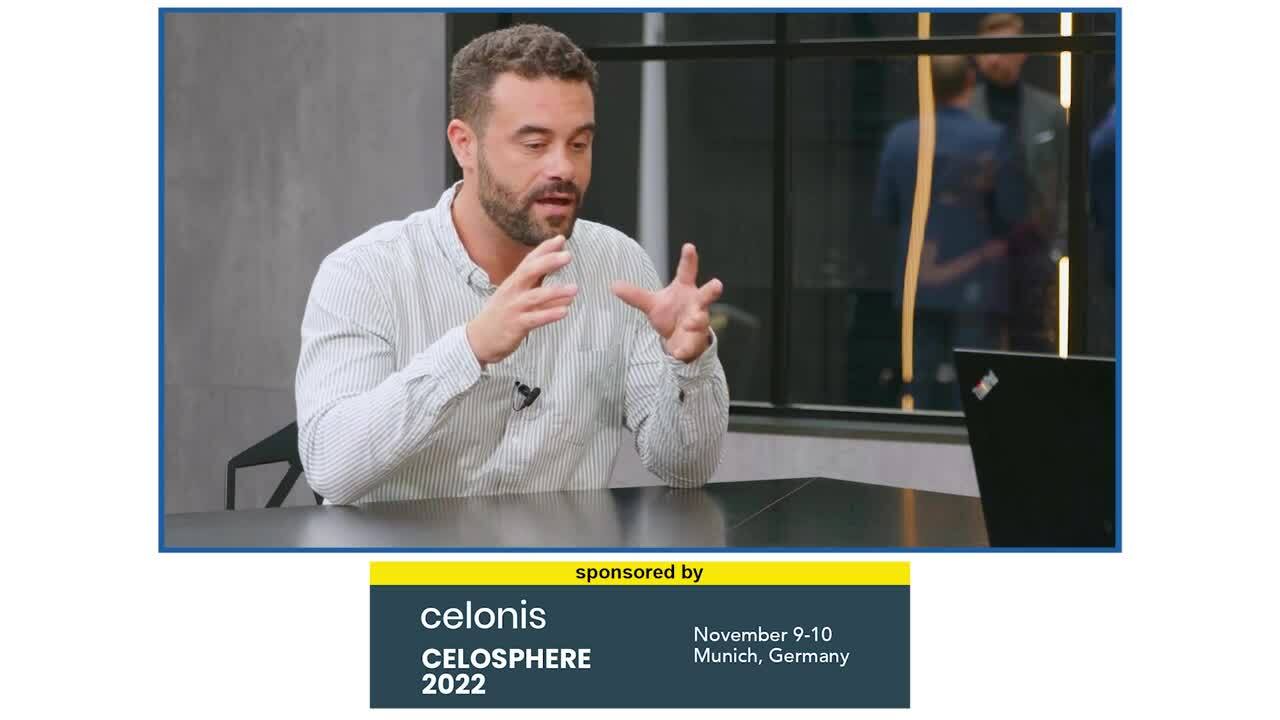
Celosphere 2022: Energy, excitement and taking process mining to the next level
Acceleration Economy analysts Tom Smith and Kieron Allen where live in Munich reporting from Celosphere 2022. After the keynote event, the pair gathered in the Cloud Wars studio on the expo hall floor to recap the opening remarks from Celonis Co-Founder and Co-CEO Alex Rinke, Wil van der Aalst, Chief Scientist, and the product announcements from Vaish Sashikanth, Chief Engineering Officer, and Ariel Bardin, Chief Product Officer.

The following is a transcript of the interview, edited for readability.
Celonis takes Process Mining to the next level
Tom Smith: Great to be together for the first time. And you and I both just came out of the opening keynote from Celosphere. We heard from co-CEO Alex Rinke. We heard from Wil van der Aalst, who is the Godfather of Process Mining.
Pretty inspirational stuff. And the place is packed. The room was packed. It was standing room only. You can feel a lot of energy here. That's my initial take. What are your impressions?
Kieron Allen: Following up on your idea of the energy, it was quite amazing actually. Inside the room, there were close to 3,000 people, and it was hot. You could feel the energy, you could feel the excitement. And Alex Rinke, when he opened it, it didn't disappoint. From that point onwards, it was a really, really interesting keynote.
Tom Smith: Really, some big vision coming from both Alex and Wil van der Aalst. And I thought I'd share a couple of the statements Alex made. The new products, which we'll talk about momentarily, are really designed to give customers additional perspectives, new perspectives, and to get employees to have a common perspective. It's not about changing the perspective of people, it's about developing a new perspective through the Celonis technology.
He said, "We wouldn't be Celonis if we didn't think it was time to take things to the next level," which I thought was an interesting statement. And he also said, "Once you see this technology, you won't be able to unsee it," and I know you have some thoughts on that, having seen some demos.
Kieron Allen: Having seen some of those demos, I absolutely will not be unseeing what Alex Rinke's revealed today.
I think you're right, his focus was on developing on existing technologies. And I think that's the key here. It's not about reinventing the wheel. What Alex and his team have revealed today is that their new processes are building on the existing processes that already work. And he's shown how you can bring these together to actually start facing challenges that maybe didn't exist a few years ago when the tool was first developed.
Tom Smith: Yes, and from a product standpoint, I think Process Sphere was probably the biggest highlight. And from my perspective, what this is all about is helping. It's recognizing the interconnectedness of business processes, helping a business understand where things might break down, where they may need to be fixed or addressed, or there are opportunities to improve a process.
Before Process Sphere, it was more of a process by process analysis. This is more of a global comprehensive analysis, and reflecting the interconnectedness of the business. I think it has really great potential for their customers.
Kieron Allen: I do. And he describes it as a move from 2D to 3D. And I think that's a really good way of describing it.
Originally, Celonis described their technology as an X-ray of business processes, and this is now described as an MRI. And I think that's a really good vision. If you want to learn about what Process Sphere is, think about it as an MRI. It's evolving the existing x-ray, but it's still focusing on the same problems and the same solutions. But instead of just being able to look at one route, you can actually see the entire route altogether, and all the possible entry and exit points that you need to take to achieve that vision in the end.
Also: Process Sphere™ is a capability of Celonis EMS built on a novel type of process mining technology called object-centric process mining (OCPM).
Celonis Business Miner: Democratizing Process Mining and Execution Management
Tom Smith: And another big product highlight is called Business Miner. And this is really about democratizing this technology. And Alex Rinke went so far as to say, "You don't even need to know what a process is in order to use this," and, kind of a bold statement, but I think that's the objective that they have.
It's presented as a question and answer type format. So based on your persona, your role in the business, you can query the system, or the system can even recommend queries about things you can drill into. And I think that really makes it accessible for a lot more people.
Kieron Allen: I must say, I was very excited about this technology. I think they've definitely democratized the ‘process mining’ process.
As you said, that's a bold statement, to say you don't even need to know anything about process mining. But actually, when they showed the demonstration, you really don't. You're led through the process. There's a question, there's an answer. You don't even have to know what your ultimate question is. The technology leads you through using generic question and answer formats from your sector, from your department. And at the end, you're presented with these insights that aren't just percentage points, showing you what the percentage is in terms of savings for your department, but they're dollar value as well. It's both of those.
I thought it's really intuitive, a really interesting way of looking at process mining for a wider business user case.


